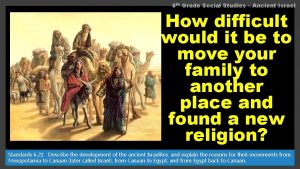AFRICA Mr Mikes 7 th grade Social Studies















- Slides: 15

AFRICA Mr. Mike’s 7 th grade Social Studies

AFRICA’S GEOGRAPHY • Africa is the world’s second-largest continent. • Most of Africa lies in the tropics. Here dry, sweeping grasslands, known as savannas, have high temperatures and uneven rains. • North and south of the savannas are the deserts—the Sahara to the north and the Kalahari to the southwest. • Africa has many long rivers. You know about the Nile River and the civilizations of Egypt and Kush along its banks. In West Africa, the Niger River is very important. The rich soil along the Niger grows many crops and gave rise to several civilizations in West Africa

AFRICAN TRADING EMPIRES THE BANTU • Many people in Africa share a common background. This is because much of early Africa was settled by a people called the Bantu thousands of years ago. • Around 3000 B. C. , fishing groups along the Benue River (BAYN • way) packed belongings in their canoes and began moving throughout Africa. The wanderers called themselves Bantu, meaning “the people. ” By A. D. 400, Bantu peoples had settled most of Africa. • Wherever they went, the Bantu took their culture with them. They spread skills such as pottery making, mining, and ironworking. They also spread their language and beliefs. The Bantu, for example, believed in one supreme creator and a spirit world where ancestors live. This became a common belief in many places in Africa.

TRADE CARAVANS BEGIN THE BERBERS • The Bantu people spread across much of Africa but the Sahara prevented them from moving into North Africa. About 400 B. C. , North African people known as the Berbers found a way to cross the Sahara to West Africa, and trade began. • For hundreds of years, the Berbers transported goods on horses and donkeys, which often died in the hot Sahara. When the Romans conquered North Africa, they introduced camels from central Asia. Camels revolutionized trade. Their broad feet did not sink in the sand, and their humps stored fat for food. In addition, they could travel many days without water. • Traders grouped hundreds of camels together to form caravans. They traded salt and cloth from North Africa and the Sahara for gold and ivory from western Africa. This trade led to the growth of cities in western Africa. Eventually, rulers of these cities began to build empires. In the Middle Ages, these African empires were bigger than most European kingdoms in wealth and size. The first empire to develop was Ghana (GAH • nuh).

THE KINGDOM OF GHANA • Ghana rose to power in the A. D. 400 s. It was located where several trade routes came together. Trade routes reached across the Sahara into North Africa and down the Niger River. For traders to meet, they had to pass through Ghana. Passage required a fee—a tax paid to Ghana’s rulers. These taxes made Ghana rich. • Why pay a tax? Ghana knew how to make iron weapons and it used these weapons to conquer its neighbors. Second, Ghana built a huge army. Third, people wanted the trade items, especially salt and gold, at almost any price. West Africans needed salt to flavor and preserve food, and Berber merchants wanted gold so they could buy goods from Europe and the Arabs.

THE KINGDOM OF MALI • In the 1200 s, the kingdom of Mali conquered what was left of Ghana. West African griots, or storytellers, give credit to a great warrior-king named Sundiata Keita — the “Lion Prince. ” Sundiata, who ruled from 1230 to 1255, seized the capital of Ghana in 1240. He then won control of lands from the Atlantic coast to the trading city of Timbuktu. His conquests put Mali in control of the goldmining areas, allowing him to rebuild the gold and salt trade.

THE KINGDOM OF MALI Mali began a slow decline after the death of its last strong king, Mansa Musa, in 1332. The kings who followed failed to stop Berber invaders who soon conquered Timbuktu.

RELIGION IN AFRICA • There are three major religions in Africa: Islam, Christian, and Traditional. • Traditional religion varied from place to place but there were some common beliefs: Belief in one creator • Belief in lesser gods and goddesses that worked for the creator • Belief that the spirit of dead relatives stayed in the village to help the living • Belief in the protective power of juju and magic (charms or amulets), shrines and other sacred objects. •

TRADITIONAL RELIGION • Traditional religion varied from place to place but there were some common beliefs: Belief in one creator • Belief in lesser gods and goddesses that worked for the creator • Belief that the spirit of dead relatives stayed in the village to help the living • Belief in the protective power of juju and magic (charms or amulets), shrines and other sacred objects. •

TRADITIONAL RELIGION Two Worlds Religion in Africa is not a discreet human activity, separate from other aspects of living. This is in contrast to many branches of Christianity, where the spiritual is separate from the physical, and heaven is entirely separate from earth. In African traditional religion, as in many other ancient belief systems in other parts of the world, religion, or the spiritual permeates every aspect of life.

TRADITIONAL RELIGION LANDSCAPE The landscape is a source of spiritual contemplation and worship. The Gikuyu of Kenya, for example, pray facing Mount Kenya. The Shona, of Zimbabwe, have sacred hills and caves. The Lugbara and Langi, both from Uganda, worship sacred rocks. The landscape may also be populated by many spirits, some good some bad.

TRADITIONAL RELIGION ANCESTORS The ancestral spirits also mediate between this world and the spirit world. They play a large part in most cultures, are easily accessible, and generally considered to be kind. They bless and give advice and warnings to the people. They are, in many ways, as real to the people who talk to them, as the living. A Chokwe ancestor mask from Central Africa

TRADITIONAL RELIGION ILLNESS Illness is an area where the physical and spiritual meet. There is no fixed boundary between body and soul. In Africa illness may be treated with herbs very successfully. But often it will also have a spiritual dimension. It may be seen as a punishment from God or the deities, or it might be the result of ill will from an enemy. In this case some form of spiritual power will be needed to combat it; a medicine man or woman will then be consulted.

TRADITIONAL RELIGION ACTS OF CREATIVITY Every individual has the power to commune with divine beings through prayer and sacrifice, but the well being of each individual is tied up with the well being of the community. Theatre, dancing, singing and music are communal forms of religious expressions. They may act as a prelude to war, celebrate a good harvest, mark a birth, a marriage, or a death. Mbube, the name of the song, means Lion in Zulu. This traditional song was used to describe the feelings of the people after the death of Shacka the Zulu king known as the lion. So the song is “The Lion Sleeps Tonight” means he is not dead but sleeping. The song over time became a traditional African children’s lullaby telling the child you are safe because the lion is sleeping (Uyimbube or oo-ee -muboobe in Zulu).

MUSLIM AFRICA • According to Arab oral tradition, Islam first came to Africa with Muslim refugees fleeing persecution in the Arab peninsula. This was followed by a military invasion, some seven years after the death of the prophet Mohammed in 639, under the command of the Muslim Arab General, Amr ibn al-Asi. It quickly spread West from Alexandria in North Africa.
 Cns10 mikes
Cns10 mikes Mikes bikes simulation single player
Mikes bikes simulation single player Living together social studies grade 6
Living together social studies grade 6 History grade 9 unit 5
History grade 9 unit 5 Social studies 8 textbook
Social studies 8 textbook Day 9 grade 8 social studies staar review
Day 9 grade 8 social studies staar review Chapter 3 social studies grade 9
Chapter 3 social studies grade 9 Social studies chapter 2
Social studies chapter 2 Nsms 6th grade social studies.weebly
Nsms 6th grade social studies.weebly Grade 7 social studies empowerment
Grade 7 social studies empowerment 8th grade social studies
8th grade social studies 4th grade social studies vocabulary
4th grade social studies vocabulary Paradigm shift from women studies to gender studies
Paradigm shift from women studies to gender studies Social thinking and social influence
Social thinking and social influence Social thinking social influence social relations
Social thinking social influence social relations Physical features of south africa grade 5
Physical features of south africa grade 5





























